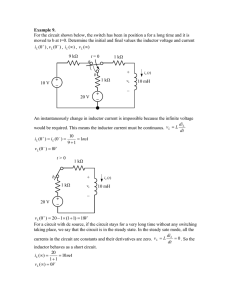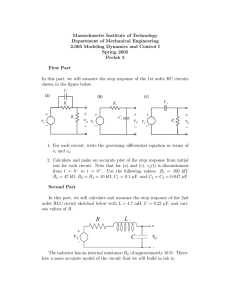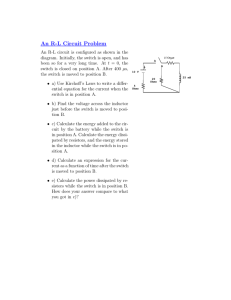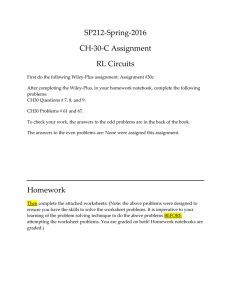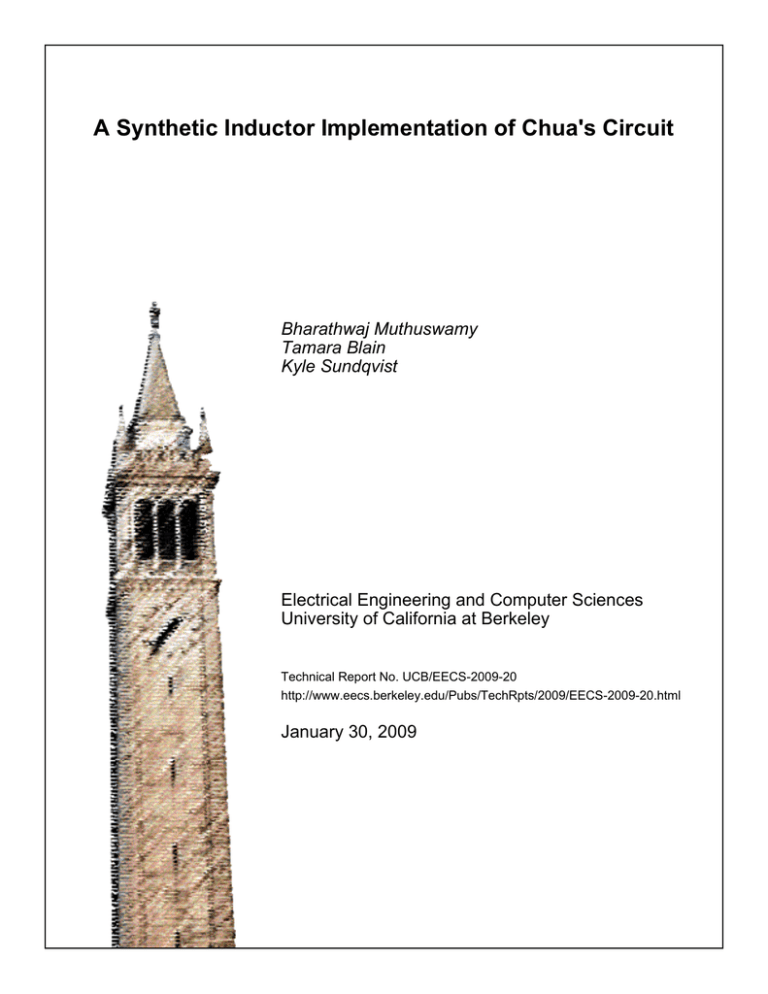
A Synthetic Inductor Implementation of Chua's Circuit
Bharathwaj Muthuswamy
Tamara Blain
Kyle Sundqvist
Electrical Engineering and Computer Sciences
University of California at Berkeley
Technical Report No. UCB/EECS-2009-20
http://www.eecs.berkeley.edu/Pubs/TechRpts/2009/EECS-2009-20.html
January 30, 2009
Copyright 2009, by the author(s).
All rights reserved.
Permission to make digital or hard copies of all or part of this work for
personal or classroom use is granted without fee provided that copies are
not made or distributed for profit or commercial advantage and that copies
bear this notice and the full citation on the first page. To copy otherwise, to
republish, to post on servers or to redistribute to lists, requires prior specific
permission.
1
A Synthetic Inductor Implementation of Chua’s
Circuit
Bharathwaj Muthuswamy, Kyle Sundqvist and Tamara Blain
Abstract—We show how to build an inductorless version
of the classic Chua’s circuit. The goal is to build Chua’s
circuit quickly and easily. To this end, only off-the-shelf
components are used. A suitable inductor for Chua’s
circuit is often hard to procure. Here, the inductor is
replaced by a single op-amp synthetic inductor circuit.
The synthetic inductor is novel in the sense that it is not
a gyrator, it is a one port device and thus a simple blackbox analogy to an inductor is possible. We illustrate the
robustness of the synthetic inductor by synthesizing two
different inductor values.
I. I NTRODUCTION
I
Fig. 2. The i-v characteristic of the nonlinear resistor NR . Every
physically realizable nonlinear resistor is eventually passive - the
outermost segments must lie within the first and third quadrants of
the v-i plane for sufficiently large |v| and |i|.
N this paper, we propose an off-the-shelf implementation of Chua’s circuit. This circuit is the
paradigm for generating chaotic attractors [1]. A
The state equations for Chua’s circuit are shown
schematic of Chua’s circuit is shown in Fig. 1 [4]. below.
The iR -vR graph of the nonlinear resistor NR (also
called as the Chua diode) is shown in Fig. 2 [4].
dvC1 vC2 − vC1
C1
=
− iR
(1)
dt
R
dvC2 vC1 − vC2
C2
=
+ iL
dt
R
diL
L
=−vC2
dt
In (1), iR = g(vR ) = g(vC1 ) is a piecewise-linear
function defined by [4]:
Fig. 1. Chua’s Circuit Schematic. The circuit consists of a linear
inductor L, a linear resistor R, two linear capacitors C1 and C2 and
a nonlinear resistor NR .
Bharathwaj Muthuswamy, Kyle Sundqvist and Tamara Blain are
with the University of California, Berkeley, CA, 94720 USA. Contact:
mbharat@cory.eecs.berkeley.edu,kylesun@cosmology.berkeley.edu,eb9d9@eecs.Berkeley.edu
1
g(vR ) = m0 vR + (m1 − m0 )[|vR + Bp | − |vR − Bp |]
2
(2)
From Fig. 2, it can be inferred that the slopes in the
inner and outer regions are m1 and m0 respectively;
±Bp denote the breakpoints. Good references for
understanding Chua’s circuit are [5] and [4].
It is difficult to obtain precise values of the inductor needed to build the circuit in Fig. 1. Also, the
inductor is quite bulky and it cannot be integrated
on a chip. Moreover, many commercially available
inductors have a core that is added to increase
the inductance (and hence reduce the number of
2
windings needed). But, this is known to have the
effects of adding distortion to the signal via hysteresis [8]. Given the sensitive dependence on initial
conditions for the chaotic circuit, this would be
largely undesirable. One solution is to simulate the
inductor using a gyrator, as demonstrated by [7],
which uses a two op-amp implementation of the
gyrator. In this paper, we use a simpler synthetic
inductor implementation. Specifically:
1) We use only one op-amp for the synthetic
inductor.
2) All components are off-the-shelf (a parts list
is included at the end of this paper).
The organization of this paper is as follows: in
Section II, we give a brief overview of the component values used in the 18mH inductor version of
Chua’s circuit. In Section III, we give the expression
for the impedance of the synthetic inductor (the
derivation is given in the Appendix). In Section IV,
we show simulation results using a 30-day fully
functional trial version of National Instruments’
MultiSim suite [3]. This circuit simulator was chosen over PSPICE because MultiSim is easier to
use. In Section V, we show experimental results
using oscilloscope waveforms from the physical
implementation of the circuit. In Section VI, we
implement a different inductor value using the synthetic inductor (the 8.2 mHChua’s circuit from [5]).
We conclude the paper with a parts list, suggestions
for future work and acknowledgments.
II. C HUA’ S C IRCUIT C OMPONENT VALUES
Fig. 3 shows the realization of Chua’s circuit
that will be used in this paper. In comparison to
Fig. 4, the inductor in Fig. 3 has been replaced by
our synthetic inductor and the Chua diode has been
implemented using Kennedy’s two op-amp implementation [4]. The component values for everything
but the synthetic inductor were obtained from [4].
The component values for the synthetic inductor are
given in the next section.
From Fig. 3 and [4], the parameters m0 , m1
and ±Bp for the Chua diode i-v in Fig. 2 can be
computed as:
m0 = −0.409mS, m1 = −0.756mS, Bp = 1.08V
(3)
Fig. 4. Chua’s Circuit with component values for investigating chaos,
the component values are from [4]. Compare with Fig. 3.
Fig. 5. The synthetic inductor circuit. The goal is to derive an
expression for Zin . We assume the op-amp is operating in the linear
region. The derivation is in the appendix
III. T HE S YNTHETIC I NDUCTOR I MPEDANCE
Fig. 5 shows our modified version of the synthetic
inductor from [2].
If RL = 10−4 Rg (so that RL << Rg ) in Fig. 5,
we have:
Zin ≈ RL + jωRL Rg C
(4)
The derivation of (4) is given in the Appendix. In
our case, RL = 10Ω, Rg = 100kΩ and C = 18nF ,
so we have the equivalent circuit of Fig. 6 for an
18mH inductor.
Fig. 6.
18mH synthetic inductor circuit.
3
IV. M ULTI S IM S IMULATION R ESULTS
MultiSim 10 has been used to simulate Chua’s
circuit. A free 30-day evaluation version of MultiSim 10 can be downloaded from [3]. Please download the professional edition of MultiSim 10. This
edition has the simulation models for the LMC6482
op-amp. A MultiSim 10 simulation file for the
Chua’s circuit discussed in this paper can be downloaded from [6].
Fig. 7 shows simulated attractors obtained from
MultiSim 10. We show a period-doubling route to
chaos by varying C1 [4], the other parameters are
fixed. Attractor periods shown are period-1, period2, period-4 and a Double-Scroll Chua attractor.
V. E XPERIMENTAL R ESULTS
Fig. 8 shows a series of measured attractors from
the physical circuit. Note that the experimental C1
values used for illustrating the period doubling route
to chaos closely match the C1 values from the
simulated version (refer to Fig. 7).
VI. 8.2 M H INDUCTOR VERSION OF C HUA’ S
CIRCUIT
To examine the robustness of this circuit, let us
implement Chua’s circuit with component values
in [5]: L = 8.2 mH, C2 = 55 nF, R =
1.33 kΩ, C1 = 5.5 nF . However, the capacitor values are not off-the-shelf, therefore we implemented
L = 8.2 mH, C2 = 47 nF, C1 = 4.7 nF . The 2k
potentiometer has been set to 1.5 kΩ. The synthetic
inductor capacitor has been changed to C = 8.2 nF
to implement the 8.2 mH inductor. The schematic
of this circuit is shown in Fig. 9. A simulated and
experimental Double-Scroll is also shown.
TABLE I
PARTS LIST FOR 18 mH
AND 8.2 mH SYNTHETIC INDUCTOR
VERSIONS OF C HUA’ S CIRCUIT
L
RL
C
Rg
C2
R
18 mH
8.2 mH
10 Ω
18 nF
100 kΩ
100 nF
2 kΩ pot.
10 nF
10 Ω
8.2 nF
100 kΩ
47 nF
2 kΩ pot.
4.7 nF
TABLE II
C HUA D IODE PARTS LIST FOR 18 mH
AND
8.2 mH
C1
SYNTHETIC
INDUCTOR
L
R1
R2
R3
R4
R5
R6
18 mH
220 Ω
220 Ω
2.2 kΩ
22 kΩ
22 kΩ
3.3 kΩ
8.2 mH
220 Ω
220 Ω
2.2 kΩ
22 kΩ
22 kΩ
3.3 kΩ
and chaos phenomenon. Therefore, possible opamps that can be used are the LMC6482, TL082
and the AD822AN. Moreover, the TL082 and the
AD822AN can be powered using ±9 V supplies.
This makes them attractive for use with ±9 V
batteries.
B. Future Work
In this paper, we discussed a single op-amp
synthetic inductor version of Chua’s circuit. We
implemented Chua’s circuit for two synthetic values
of inductance: 18 mH and 8.2 mH. An interesting
problem would be to explore the maximum possible
bandwidth of this circuit.
A PPENDIX
T HE S YNTHETIC I NDUCTOR I MPEDANCE
D ERIVATION
We will now derive the equivalent impedance
VII. C ONCLUSIONS AND F UTURE W ORK
of the synthetic inductor, as seen from its input
A. Parts List
terminals. Refer to Fig. 5.
Using Thevenin’s theorem, we can write an exThe parts list for both the 18 mH and the 8.2 mH
circuit are given in Tables I and II. All resistors are pression for Zin :
5% tolerance. Capacitors are mylar and have 10%
Vin (jω)
tolerance.
Zin =
Iin (jω)
The op-amp that was used in this paper is the
LMC6482 from National Semiconductor. However,
Vin (jω)
=
we replaced the LMC6482 in the circuit with the
I1 (jω) + I2 (jω)
TL082 and the AD822AN (pin-for-pin compatible
Vin (jω)
= Vin (jω)−Vn (jω)
(5)
op-amps with the LMC6482). Both the TL082
Vin (jω)
+
1
RL
Rg + jωC
and the AD822AN circuits displayed bifurcation
4
Assuming the op-amp is operating in the linear
region:
Vn (jω) = Vp (jω)
Rg
Vn (jω) =
1 · Vin (jω)
Rg + jωC
(6)
Substituting for Vn (jω) in (5) from (6) and simplifying:
Zin =
Vin (jω)
Vin (jω)−
Rg
Rg +
·Vin (jω)
1
jωC
+
RL
=
1
1−
Rg
Rg +
1
jωC
+
RL
=
Vin (jω)
1
Rg + jωC
1−
1
1
Rg + jωC
RL
+
Rg
1
Rg + jωC
RL
1
Rg + jωC
(7)
≈
=
=
RL
1−
Rg
1
Rg + jωC
+
10−4 Rg
1
Rg + jωC
RL
1−
Rg
1
Rg + jωC
RL (Rg +
Rg +
1
jωC
RL (Rg +
1
)
jωC
− Rg
1
)
jωC
1
jωC
1
+ Rg )
jωC
= RL + jωRL Rg C
= jωRL C(
(8)
Thus, if RL = 10−4 Rg (so that RL << Rg ), we
have:
Zin ≈ RL + jωRL Rg C
ACKNOWLEDGMENT
Many thanks to Prof. Pravin Varaiya for insightful
discussions on chaos. Prof. Joos Vandewalle was
very helpful in providing valuable comments. Many
thanks to the students in EE100 Summer 2007 at the
University of California, Berkeley. They provided
valuable feedback on how to build a simple off-theshelf version of Chua’s circuit.
R EFERENCES
Let RL = 10−4 Rg (so that RL << Rg ). Then
substituting for RL in the denominator of (7):
Zin =
Fig. 10. The synthetic inductor circuit from Fig. 5 can be modelled
as a parasitic resistance RL in series with an inductance RL Rg C.
(9)
Fig. 10 shows the circuit equivalent of (9).
If RL = 10Ω, Rg = 100kΩ and C = 18nF , we
have the equivalent circuit of Fig. 6 for an 18mH
inductor.
[1] L. O. Chua, “The genesis of chua’s circuit,” Archiv for Elektronik
and Uebertragungstechniko, vol. 46, no. 4, pp. 250–257, 1992.
[2] P. Horowitz and W. Hill, The Art of Electronics. Cambridge,
Massachussetts: Cambridge University Press, 1989.
[3] N. Instruments. (2008, February) Multisim professional edition
30-day trial version. [Online]. Available: http://www.ni.com/
multisim
[4] M. P. Kennedy, “Robust op-amp realization of chua’s circuit,”
Frequenz, vol. 46, pp. 66–80, 1992.
[5] T. Matsumoto, L. O. Chua, and M. Komuro, “The double scroll,”
IEEE Transactions on Circuits and Systems, vol. CAS-32, no. 8,
pp. 798–818, August 1985.
[6] U. of California Berkeley. (2008, February) Nonlinear elecotrnics
laboratory chaos in chua’s circuit homepage. [Online]. Available:
http://nonlinear.eecs.berkeley.edu/chaos/chaos.html
[7] L. Torres and L.A.Aguirre, “Inductorless chua’s circuit,” Electronics Letters, vol. 36, no. 23, pp. 1915–1916, 2000.
[8] O. S. University. (2008, May) Physics 517/617: Introduction to
electronics. [Online]. Available: http://www.physics.ohio-state.
edu/∼durkin/phys617/
Fig. 3. Chua’s Circuit screen capture from MultiSim’s schematic editor. The 18 mH inductor has been replaced with the single op-amp synthetic inductor and the Chua diode has been
implemented using Kennedy’s robust two op-amp implementation [4]. The batteries are not shown for clarity purposes, rather we have indicated the power supply voltages at the respective
nodes.
5
6
(a) C1 = 10.7 nF
(b) C1 = 10.4 nF
(c) C1 = 10.3 nF
(d) C1 = 9.8 nF
Fig. 7. Simulated attractors from MultiSim 10 with component values RL = 10 Ω , Rg = 100 kΩ , C = 18 nF , C2 = 100 nF , R =
1.83 kΩ. C1 is varied to show the period-doubling route to chaos. Horizontal axis is vC1 ; Vertical axis is vC2 .
(a) C1 = 13.2 nF
(b) C1 = 12.7 nF
(c) C1 = 12.2 nF
(d) C1 = 10 nF
Fig. 8. Measured attractors (using an HP54645D oscilloscope) with component values RL = 10 Ω , Rg = 100 kΩ , C = 18 nF , C2 =
100 nF , R = 1.83 kΩ. C1 is varied to show the period-doubling route to chaos. Horizontal axis is vC1 ; Vertical axis is vC2 . Scales are
Vertical axis: 1.00 V/div for (a), 0.5 V/div for (b) and (c), 1.00 V/div for (d); Horizontal axis: 0.2 V/div for (a), (b) and (c), 1.00 V/div for
(d).
(c) Experimental Double-Scroll
Fig. 9. MultiSim schematic, simulated Double-Scroll and experimental Double-Scroll for the 8.2 mH version of Chua’s circuit. Component values are C = 8.2 nF, C2 = 47 nF, R =
1.5 kΩ, C1 = 4.7 nF . The Chua diode is unchanged from Fig. 3.
(b) Simulated Double-Scroll
(a) Screen capture of MultiSim schematic for 8.2 mH version of Chua’s circuit
7


